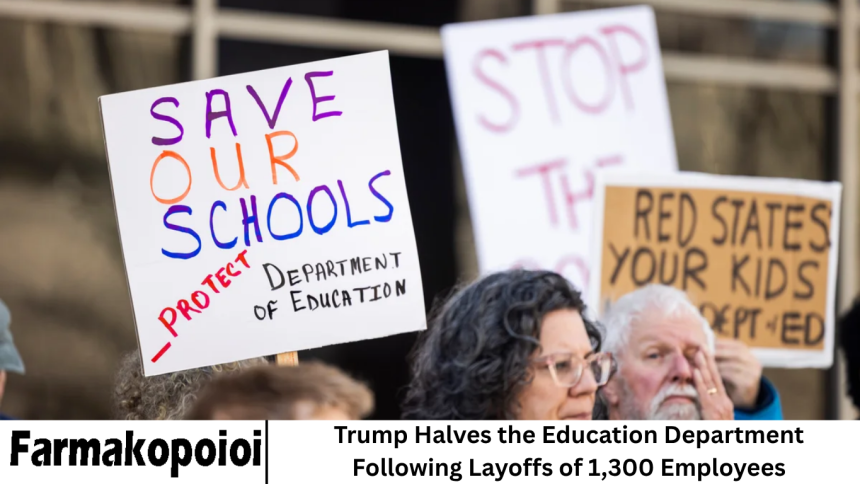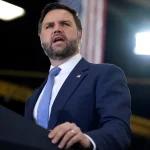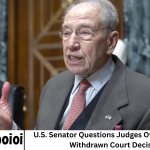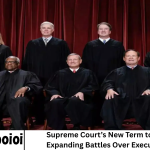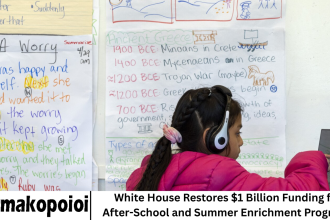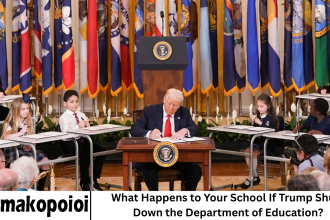In one of the most sweeping government shake-ups in recent memory, President Donald Trump has cut the U.S. Department of Education in half after laying off roughly 1,300 employees. The move, which the administration says is part of a plan to “restore power to states.
- A Long-Awaited Move: Trump’s War on Federal Education Bureaucracy
- How the Layoffs Happened
- The Political Context
- The Legal Battle
- Effects on Education Programs
- Title I and Federal Grants
- Special Education Services
- Student Loans and Financial Aid
- Civil Rights Enforcement
- Data Collection and Research
- Supporters’ Perspective
- Critics’ Perspective
- Inside the Department: Employee Reactions
- States Step Up — or Struggle
- What Comes Next
- Broader Implications for U.S. Education
- Frequently Asked Questions
- Conclusion
And parents,” represents one of the boldest efforts yet to shrink the federal government’s role in education. The layoffs have sparked fierce political debate. Supporters argue that the department had become bloated, inefficient, and ideologically biased.
While critics warn that cutting it so deeply could cripple essential programs — from student loans to special education enforcement. As states and schools brace for the consequences, the decision signals a massive transformation in how education will be managed, funded, and overseen across the United States.
More Read: Building Real-World Skills: Inside High School Career and Technical Programs
A Long-Awaited Move: Trump’s War on Federal Education Bureaucracy
President Trump’s disdain for the Department of Education is nothing new. Since his first term, he has often described the agency as an unnecessary federal intrusion into state affairs. He argued that decisions about schools, curriculum.
And student funding should be handled by local communities — not bureaucrats in Washington. During his 2024 campaign, Trump repeatedly promised to “shut down the Department of Education” altogether.
While completely eliminating a cabinet-level department would require an act of Congress, the president can still reduce its size, budget, and operational capacity. The 2025 layoffs represent a major step toward that goal.
The cuts were justified as part of a broader initiative to reduce the size of the federal government, eliminate “waste,” and return decision-making to the states. In practical terms, though, the layoffs effectively remove half of the Department’s workforce — a move that critics say is functionally equivalent to dismantling it.
How the Layoffs Happened
A Massive Reduction in Force
The Department of Education began the layoffs under what’s called a “Reduction in Force” or RIF — a legal process that allows federal agencies to permanently terminate positions for reasons of budget, reorganization, or efficiency. More than 1,300 employees received notice that their jobs were being eliminated.
This reduction affected nearly every division within the Department, from policy offices to grant management teams. The process unfolded over several weeks, leaving many workers uncertain until the last moment whether they would be asked to stay or go.
Which Offices Were Hit the Hardest
Some of the hardest-hit divisions included:
- The Office of Elementary and Secondary Education (OESE): This office oversees federal grants to public schools, including Title I funding for low-income districts. With hundreds of staff cut, the ability to process grants and monitor state programs has been sharply reduced.
- The Office for Civil Rights (OCR): This division investigates discrimination cases involving race, gender, or disability in schools. With regional offices shuttered and staff numbers cut, experts worry that many cases will go unresolved.
- The Office of Special Education and Rehabilitative Services (OSERS): Responsible for supporting students with disabilities, OSERS saw deep staffing cuts, raising fears about enforcement of the Individuals with Disabilities Education Act (IDEA).
- Federal Student Aid (FSA): Although the White House insisted that student aid services would not be disrupted, insiders warn that fewer employees could slow loan processing, debt relief programs, and oversight of student loan servicers.
- Communications and Outreach Offices: Teams that connect the Department to local districts and the public have also been reduced, limiting direct communication with states and educators.
A Cost-Saving or a Power Shift?
The administration insists that the layoffs will save taxpayers hundreds of millions of dollars annually. However, analysts note that cutting so many staff may create inefficiencies that outweigh those savings. With fewer people to monitor grants and enforce compliance, errors or fraud could rise — ultimately costing the government more.
Critics argue the layoffs are not really about cost-cutting but about shifting power away from the federal level. By making the Department smaller, the White House effectively limits its ability to influence education policy, leaving states to make their own rules.
The Political Context
Ideological Motivation
For decades, conservative leaders have argued that the federal government has no constitutional role in education. The Department of Education was created in 1979, and since then it has been a frequent target for elimination by Republicans who see it as unnecessary and politically liberal in its approach.
Trump’s move to halve the Department fits neatly into that long-standing conservative goal. His allies in Congress have praised the decision as a long-overdue step toward returning power to local school boards and parents.
Opposition from Democrats and Unions
Democrats, education advocates, and teachers’ unions have condemned the layoffs as reckless and politically motivated. They argue that the Department plays a crucial role in ensuring equal access to education, enforcing civil rights laws, and supporting schools that serve disadvantaged communities.
Unions representing federal employees have already filed grievances and lawsuits challenging the layoffs. State attorneys general in several Democratic-led states have also taken the administration to court, claiming that the cuts violate federal law and undermine congressionally mandated programs.
The Legal Battle
The legality of the layoffs remains hotly contested. Opponents argue that cutting so many employees makes it impossible for the Department to fulfill its statutory duties. For example, federal law requires the government to administer student aid, enforce civil rights protections.
And monitor special education funding. If the Department lacks enough staff to do so, critics claim it is in violation of the law. Several lawsuits have been filed seeking to reverse the layoffs. Lower courts initially ruled in favor of reinstating some employees.
But subsequent appeals have allowed the administration to move forward — at least temporarily. The final outcome may hinge on how courts interpret the balance between executive authority and congressional mandates.
Effects on Education Programs
Title I and Federal Grants
One of the most immediate concerns is the potential delay in distributing federal funds to states and school districts. Title I, which supports low-income schools, depends on federal staff to process applications, approve budgets, and monitor compliance.
With fewer workers, states could face significant delays in receiving money they depend on each year.
Special Education Services
Perhaps the most alarming impact involves special education. The Individuals with Disabilities Education Act (IDEA) requires federal oversight to ensure that schools provide appropriate services to students with disabilities.
With fewer staff in the Office of Special Education, enforcement will likely weaken. Parents and advocacy groups worry that children with disabilities could lose vital protections.
Student Loans and Financial Aid
The Department of Education manages roughly $1.6 trillion in federal student loans. Cutting staff in the Federal Student Aid division risks slowing down customer service, loan forgiveness programs, and regulatory oversight of private loan servicers.
Even small disruptions could have major consequences for millions of borrowers.
Civil Rights Enforcement
The Office for Civil Rights, which investigates discrimination in schools and universities, will now have fewer investigators. This could lead to backlogs, fewer investigations, and slower resolutions of complaints related to race, gender, or disability discrimination.
Data Collection and Research
The Department also collects critical education statistics used by researchers, states, and policymakers. Staffing reductions in data divisions may make it harder to track national trends, from graduation rates to student achievement, undermining the government’s ability to respond to emerging problems.
Supporters’ Perspective
Trump’s supporters argue that the downsizing was long overdue. They claim the Department has grown bloated over decades, duplicating efforts already managed by state education departments.
Key arguments from supporters include:
Local Control: Education decisions should be made by parents, teachers, and local leaders who understand their communities — not by bureaucrats in Washington.
- Efficiency: The Department’s administrative layers slow down progress and create red tape for schools trying to access federal funds.
- Cost Savings: Reducing staff lowers payroll expenses and allows the government to redirect resources to classrooms instead of federal offices.
- Ideological Neutrality: Supporters claim the federal Department often pushes liberal social agendas, particularly around gender identity, race-based programs, and curriculum guidance. Reducing its influence, they argue, ensures that states can set their own standards free from federal ideology.
Critics’ Perspective
Critics see the layoffs as an attack on public education and civil rights. Their main concerns include:
- Loss of Oversight: Without federal oversight, states might roll back protections for marginalized students, weaken accountability standards, or misuse federal funds.
- Equity Gaps: Wealthier states and districts can manage independently, but poorer areas rely heavily on federal support. Reducing that support risks deepening inequality.
- Legal Noncompliance: Many federal education laws require oversight. If the Department cannot enforce them, the government could face lawsuits from students and advocacy groups.
- Chaos and Confusion: Sudden staffing cuts could create disorganization and delay critical funding cycles, leaving states unsure whom to contact for guidance.
Inside the Department: Employee Reactions
For many federal employees, the layoffs were devastating. Workers described an atmosphere of uncertainty, fear, and sadness as colleagues packed up their offices. Some had spent decades in public service. Others had just joined under the belief that they were helping improve education nationwide.
Several employees said that morale had been low for months, as rumors of a shutdown or massive layoffs circulated. Others felt angry that their work had been dismissed as “waste” despite handling crucial responsibilities like grant management and data reporting.
Those who remain face the daunting challenge of doing the same amount of work with half the staff. Many report being assigned double workloads and having little clarity about new departmental structures.
States Step Up — or Struggle
As the Department shrinks, states are being forced to take on more responsibility. Some, particularly those with strong state education agencies, welcome the change. They argue they can now set standards without federal interference.
Others, especially smaller or poorer states, are less optimistic. Many rely on federal expertise and funding to manage programs like teacher training, bilingual education, and rural school support. Without those resources, their capacity to maintain quality may suffer.
What Comes Next
The White House has signaled that more changes may be coming. Some responsibilities traditionally managed by the Department of Education could be transferred to other federal agencies, such as:
- Health and Human Services (HHS): Potentially taking over early childhood and special education programs.
- Treasury or Small Business Administration (SBA): Possibly managing student loans and grants.
- Justice Department: Overseeing civil rights compliance in schools.
If those transfers occur, the Department of Education could be reduced even further, possibly becoming a small regulatory body rather than a full cabinet department.
Broader Implications for U.S. Education
The move to halve the Department of Education represents a turning point in American education policy. It raises major questions about the balance of power between federal and state governments and about how much responsibility Washington should have for ensuring equal opportunity in education.
Over the next few years, the consequences will become clearer. Supporters expect more freedom and innovation at the local level. Critics fear chaos, inequity, and neglect of vulnerable students. What’s certain is that the education landscape will not look the same again.
Frequently Asked Questions
Why did Trump cut so many employees from the Department of Education?
The administration argues the cuts are part of a broader effort to reduce government size, eliminate inefficiency, and return control of education to states and parents. Trump has long said the federal government should have a limited role in education.
How many people work for the Department now?
Before the layoffs, the Department employed over 4,000 people. After cutting 1,300 positions, the workforce has been reduced by roughly half, leaving around 2,000 employees to manage federal education programs.
What will happen to student financial aid and loan services?
The White House insists that student loan and aid programs will continue without disruption. However, many experts warn that with fewer employees, delays and processing errors could increase, especially during peak application seasons.
How are students with disabilities affected?
Students with disabilities may face delays or weakened enforcement of their rights. The Office of Special Education lost many staff responsible for monitoring state compliance with federal law, which could make it harder for parents to secure support for their children.
Can the Department of Education be shut down completely?
Legally, only Congress can eliminate a cabinet-level department. However, the president can drastically reduce its size and funding, effectively neutralizing it. Trump’s cuts are seen as a major step toward that outcome.
What do teachers and school districts think of the layoffs?
Reactions are mixed. Some educators support the idea of local control, but most teacher unions and school administrators worry about losing guidance, oversight, and federal funding support. Many fear it will lead to uneven standards across the country.
What’s next for federal education policy?
The future is uncertain. Court challenges could force the administration to reinstate some workers, while Congress might pass laws protecting the Department’s core programs. If not, states will assume greater control — reshaping education in ways unseen since before 1979.
Conclusion
The decision to cut 1,300 employees and effectively halve the Department of Education is more than a bureaucratic shuffle — it’s a defining moment in the national debate over who should control America’s schools. For Trump and his supporters, it’s about restoring local power, cutting waste.
And resisting what they see as federal overreach. For critics, it’s a reckless dismantling of an institution that protects civil rights, ensures equality, and supports millions of students in need. Whatever one’s perspective, this historic downsizing will have lasting consequences.


